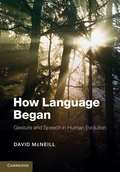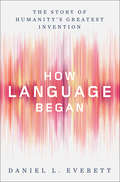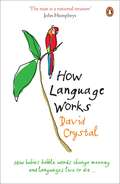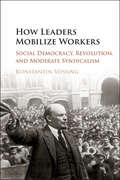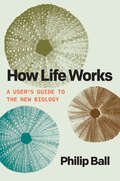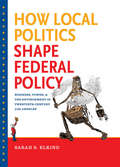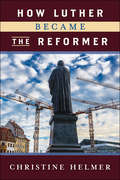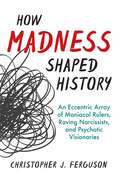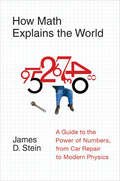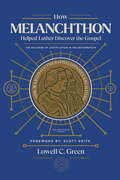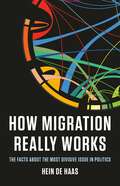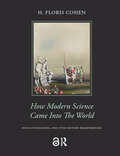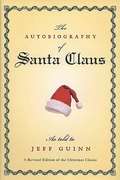- Table View
- List View
How Language Began
by David McneillHuman language is not the same as human speech. We use gestures and signs to communicate alongside, or instead of, speaking. Yet gestures and speech are processed in the same areas of the human brain, and the study of how both have evolved is central to research on the origins of human communication. Written by one of the pioneers of the field, this is the first book to explain how speech and gesture evolved together into a system that all humans possess. Nearly all theorizing about the origins of language either ignores gesture, views it as an add-on or supposes that language began in gesture and was later replaced by speech. David McNeill challenges the popular 'gesture-first' theory that language first emerged in a gesture-only form and proposes a groundbreaking theory of the evolution of language which explains how speech and gesture became unified.
How Language Began: The Story Of Humanity's Greatest Invention
by Daniel L. EverettHow Language Began revolutionizes our understanding of the one tool that has allowed us to become the "lords of the planet." Mankind has a distinct advantage over other terrestrial species: we talk to one another. But how did we acquire the most advanced form of communication on Earth? Daniel L. Everett, a “bombshell” linguist and “instant folk hero” (Tom Wolfe, Harper’s), provides in this sweeping history a comprehensive examination of the evolutionary story of language, from the earliest speaking attempts by hominids to the more than seven thousand languages that exist today. Although fossil hunters and linguists have brought us closer to unearthing the true origins of language, Daniel Everett’s discoveries have upended the contemporary linguistic world, reverberating far beyond academic circles. While conducting field research in the Amazonian rainforest, Everett came across an age-old language nestled amongst a tribe of hunter-gatherers. Challenging long-standing principles in the field, Everett now builds on the theory that language was not intrinsic to our species. In order to truly understand its origins, a more interdisciplinary approach is needed—one that accounts as much for our propensity for culture as it does our biological makeup. Language began, Everett theorizes, with Homo Erectus, who catalyzed words through culturally invented symbols. Early humans, as their brains grew larger, incorporated gestures and voice intonations to communicate, all of which built on each other for 60,000 generations. Tracing crucial shifts and developments across the ages, Everett breaks down every component of speech, from harnessing control of more than a hundred respiratory muscles in the larynx and diaphragm, to mastering the use of the tongue. Moving on from biology to execution, Everett explores why elements such as grammar and storytelling are not nearly as critical to language as one might suspect. In the book’s final section, Cultural Evolution of Language, Everett takes the ever-debated “language gap” to task, delving into the chasm that separates “us” from “the animals.” He approaches the subject from various disciplines, including anthropology, neuroscience, and archaeology, to reveal that it was social complexity, as well as cultural, physiological, and neurological superiority, that allowed humans—with our clawless hands, breakable bones, and soft skin—to become the apex predator. How Language Began ultimately explains what we know, what we’d like to know, and what we likely never will know about how humans went from mere communication to language. Based on nearly forty years of fieldwork, Everett debunks long-held theories by some of history’s greatest thinkers, from Plato to Chomsky. The result is an invaluable study of what makes us human.
How Language Works
by David CrystalIn this fascinating survey of everything from how sounds become speech to how names work, David Crystal answers every question you might ever have had about the nuts and bolts of language in his usual highly illuminating way. Along the way we find out about eyebrow flashes, whistling languages, how parents teach their children to speak, how politeness travels across languages and how the way we talk show not just how old we are but where we’re from and even who we want to be.
How Leaders Decide: A Timeless Guide to Making Tough Choices
by Greg Bustin"Greg's collection of the best and worst decisions in history is a practical, nuanced and timeless guide for today's decision-makers."—Mark Schortman, Chairman, Coca-Cola Bottlers Sales & Services, LLC Can today's leaders look to history when making tough decisions?Whether you're running a small team or an international enterprise, all leaders know the feeling of facing a tough choice. It's impossible to see into the future to predict how our decisions play out, but we can look to the momentous decisions of the past for insights on how profound choices are made. Each decision made by influential figures, from Alfred Nobel and Marie Curie to Martin Luther King, Jr., and The Beatles, have shaped our world—and now they can help you make the decisions that will determine the direction of your organization.Guiding you through fifty-two dramatic historical events and decisions that changed the course of our world, How Leaders Decide challenges decision-makers with provocative ideas and leadership lessons that will propel your business forward. Greg Bustin's well-researched and inspiring stories of high-stakes turning points in history and the leaders that made the final call will help you make sure your next decision is the one that changes everything. How Leaders Decide is an essential book for readers of Start with Why and Leaders Eat Last!Additional Praise for How Leaders Decide:"Exceptional leaders are lifelong learners, and Greg has collected, organized and presented these leadership lessons to stimulate learning, inform decision-making, and inspire action. This is a book that all teams and business leaders should read."—Elizabeth Bryant, Chief Learning Officer, Southwest Airlines"Talk about the perfect combination! In How Leaders Decide, Greg Bustin combines fascinating history with succinct leadership insights to showcase 52 of the greatest leadership decisions the world has seen"—Gordon Leidner, author of The Leadership Secrets of Hamilton
How Leaders Mobilize Workers: Social Democracy, Revolution, and Moderate Syndicalism
by Konstantin VössingThis book explains why leaders choose social democracy, revolution, or moderate syndicalism to mobilize workers, and why it matters. In some countries, leaders have responded effectively to their political environment, while others have made ill-fitting choices. Vössing explains not only why leaders make certain choices, but also how their choices affect the success of interest mobilization and subsequent political development. Using quantitative data and historical sources, this book combines an analysis of the formation of class politics in all twenty industrialized countries between 1863 and 1919 with a general theory of political mobilization. It integrates economic, political, and ideational factors into a comprehensive account that highlights the critical role of individual leaders. Explains the causes and consequences of differences in class politics. Conducts a rich and multifaceted empirical analysis using statistical and historical methods. Will appeal to readers who are interested in political mobilization, decision-making, or leadership.
How Life Works: A User’s Guide to the New Biology
by Philip BallA cutting-edge new vision of biology that will revise our concept of what life itself is, how to enhance it, and what possibilities it offers. Biology is undergoing a quiet but profound transformation. Several aspects of the standard picture of how life works—the idea of the genome as a blueprint, of genes as instructions for building an organism, of proteins as precisely tailored molecular machines, of cells as entities with fixed identities, and more—have been exposed as incomplete, misleading, or wrong. In How Life Works, Philip Ball explores the new biology, revealing life to be a far richer, more ingenious affair than we had guessed. Ball explains that there is no unique place to look for an answer to this question: life is a system of many levels—genes, proteins, cells, tissues, and body modules such as the immune system and the nervous system—each with its own rules and principles. How Life Works explains how these levels operate, interface, and work together (most of the time). With this knowledge come new possibilities. Today we can redesign and reconfigure living systems, tissues, and organisms. We can reprogram cells, for instance, to carry out new tasks and grow into structures not seen in the natural world. As we discover the conditions that dictate the forms into which cells organize themselves, our ability to guide and select the outcomes becomes ever more extraordinary. Some researchers believe that ultimately we will be able to regenerate limbs and organs, and perhaps even create new life forms that evolution has never imagined. Incorporating the latest research and insights, How Life Works is a sweeping journey into this new frontier of the life sciences, a realm that will reshape our understanding of life as we know it.
How Lincoln Learned to Read: Twelve Great Americans and the Educations That Made Them
by Daniel WolffBeginning with Benjamin Franklin and ending with Elvis Presley, author Daniel Wolff creates a series of intimate, interlocking profiles of notable Americans that track the nations developing notion of what it means to get a good education.
How Local Politics Shape Federal Policy
by Sarah S. ElkindFocusing on five Los Angeles environmental policy debates between 1920 and 1950, Sarah Elkind investigates how practices in American municipal government gave business groups political legitimacy at the local level as well as unanticipated influence over federal politics. Los Angeles's struggles with oil drilling, air pollution, flooding, and water and power supplies expose the clout business has had over government. Revealing the huge disparities between big business groups and individual community members in power, influence, and the ability to participate in policy debates, Elkind shows that business groups secured their political power by providing Los Angeles authorities with much-needed services, including studying emerging problems and framing public debates. As a result, government officials came to view business interests as the public interest. When federal agencies looked to local powerbrokers for project ideas and political support, local business interests influenced federal policy, too. Los Angeles, with its many environmental problems and its dependence upon the federal government, provides a distillation of national urban trends, Elkind argues, and is thus an ideal jumping-off point for understanding environmental politics and the power of business in the middle of the twentieth century.
How Luther Became the Reformer
by Christine HelmerNo story has been more foundational to triumphalist accounts of Western modernity than that of Martin Luther, the heroic individual, standing before the tribunes of medieval authoritarianism to proclaim his religious and intellectual freedom, “Here I stand!” How Luther Became the Reformer returns to the birthplace of this origin myth, Germany in the late nineteenth century, and traces its development from the end of World War I through the rise of National Socialism. Why were German intellectuals—especially Protestant scholars of religion, culture, and theology—in this turbulent period so committed to this version of Luther’s story? Luther was touted as the mythological figure to promote the cultural unity of Germany as a modern nation; in the myth’s many retellings, from the time of the Weimar Republic forward, Luther attained world-historical status. Helmer finds in this construction of Luther the Reformer a lens through which to examine modernity’s deformations, among them anti-Judaism, anti-Semitism, and anti-Catholicism. Offering a new interpretation of Luther, and by extension of modernity itself, from an ecumenical perspective, How Luther Became the Reformer provides resources for understanding and contesting contemporary assaults on democracy. In this way, the book holds the promise for resistance and hope in dark times.
How Madness Shaped History: An Eccentric Array of Maniacal Rulers, Raving Narcissists, and Psychotic Visionaries
by Christopher J. FergusonThis book considers the impact of psychology on world events, looking at how mental illness and personality disorders have affected history. How have mental illness and personality disorders influenced history? This lively investigation demonstrates that, when conditions are ripe, one unstable individual can create the best or worst moments of a generation or even a century. Beginning with Alexander the Great, whose megalomania caused widespread bloodshed yet powerfully shaped world history through the spread of Greek culture, the author examines the various forms of mental illness among people of great influence. These includes emperors, like the Romans Caligula and Elagabalus, kings like George III of England and Charles II of Spain, and lesser known rulers such as sixteenth-century Hungarian noblewoman Elizabeth Bathory, who is in the Guinness World Records as the most prolific female serial killer of all time. In more recent times, the author considers the mental instability exhibited by dictators Adolf Hitler, Joseph Stalin, and Idi Amin, as well as female prison guard Irma Grese, whose cruelties at Auschwitz were infamous. He also discusses rumors of cognitive decline among American presidents Woodrow Wilson, Ronald Reagan, and Donald Trump, and the ways in which American democracy copes with the disability of its leaders. And he considers cases where whole societies seem to be gripped by the madness of mob rule. Ferguson concludes with an eye toward the future, considering the power of social media to amplify fringe ideas, giving extremist and outright crazy perspectives greater exposure and influence than ever before.
How Maine Changed the World
by Nancy GriffinAs Down East Books celebrates 50 years of great book publishing, it seems appropriate to reflect uponthe contributions Maine has made that have had significant cultural and historical impacts on both theUnited States and the World. Did you know that the caterpillar tread, common on bulldozers and tanks,originated from the design of Lombard&’s steam log hauler; or that the dry plate photographic process wascreated by the Stanley brothers, who also invented a speed-record setting steam powered car and whosesister, Chansonetta, was a well-known photographer in her own right? Maxim&’s machine gun foreverchanged the practice of warfare. The humble peavey is a simple tool well-known to any forester orlumberjack. The ubiquitous lobster boat, the microwave oven, earmuffs, and Monopoly—all came fromthe minds of Mainers. This book is a celebration of Maine&’s creative ingenuity—from the very large, suchas Portland Head Light and the Penobscot Narrows Bridge to the very small, such as the toothpick and theBean boot.
How Many Miles to Babylon?: A Novel (Penguin Essentials Ser. #63)
by Jennifer JohnstonFrom a Whitbread Award–winning author: A WWI novel of loyalty and friendship &“graced with the immanent lyrical talent of the Irish writers at their best&” (Kirkus Reviews, starred review). Born to an aristocratic family on an estate outside of Dublin, Alexander Moore feels the constraints of his position most acutely in his friendship with Jerry Crowe, a Catholic laborer in town. Jerry is one of the few bright spots in Alec&’s otherwise troubled life. The boys bond over their love of swimming and horses, despite the admonitions of Alec&’s cold and overbearing mother, who scolds her son for venturing outside of his class. When the Great War begins, he seizes the opportunity to escape his overbearing mother and taciturn father, and enlists in the British army. Jerry, too, enlists—not out of loyalty to Britain, but to prepare himself for the Republican cause. Stationed in Flanders, the young men are reunited and find that, while encamped in the trenches, their commonalities are what help them survive. Now a lieutenant and an officer, Alec and Jerry again find their friendship under assault, this time from the rigid Major Glendinning, whose unyielding adherence to rank leads the two men toward a harrowing impasse that will change their lives forever.
How Maritime Trade and the Indian Subcontinent Shaped the World: Ice Age to Mid-Eighth Century
by Nick CollinsWorld-wide maritime trade has been the essential driver of wealth-creation, economic progress and global human contact. Trade and exchange of ideas have been at the heart of economic, social, political, cultural and religious life and maritime international law. These claims are borne out by the history of maritime trade beginning in the Indian Ocean and connecting to Southeast Asia, Japan, the Americas, East Africa, the Middle East especially the Persian Gulf, the Mediterranean and Europe. This development predates the end of the Ice Age with worldwide flooding and stimulated the establishment of land-based civilizations in the above regions with particular effect on the Greek and Roman empires and even China's 'Celestial' empire. The Indian subcontinent was the original major player in maritime trade, linking oceans and regions. Global maritime trade declined with the fall of Mediterranean empires and the 'dark age' in Europe but revived with Indian Ocean and Asian maritime networks. Shipping and trade studies are hugely practical but can be technical, legalistic and even dull for non-specialists. But this history is a broadly based and exciting account of human interaction at multiple levels, for general readers, specialists and practitioners. It is based on huge reading and rare sources and with an attractive writing style, and full of fascinating sidelights illuminating the historical narrative - and from an author with lifelong experience in international shipping.
How Marriage Became One of the Sacraments: The Sacramental Theology of Marriage from its Medieval Origins to the Council of Trent (Cambridge Studies In Law And Christianity)
by Philip L. ReynoldsAmong the contributions of the medieval church to western culture was the idea that marriage was one of the seven sacraments, which defined the role of married folk in the church. Although it had ancient roots, this new way of regarding marriage raised many problems, to which scholastic theologians applied all their ingenuity. By the late Middle Ages, the doctrine was fully established in Christian thought and practice but not yet as dogma. In the sixteenth century, with the entire Catholic teaching on marriage and celibacy and its associated law and jurisdiction under attack by the Protestant reformers, the Council of Trent defined the doctrine as a dogma of faith for the first time but made major changes to it. Rather than focusing on a particular aspect of intellectual and institutional developments, this book examines them in depth and in detail from their ancient precedents to the Council of Trent. Provides a comprehensive, up-to-date and critical analysis. Copiously documented with primary and secondary references for further study. Non-confessional and open to readers of all persuasions, in a field dominated by confessional and often defensive Catholic studies.
How Mass Atrocities End
by Bridget Conley-ZilkicGiven the brutality of mass atrocities, it is no wonder that one question dominates research and policy: what can we, who are not at risk, do to prevent such violence and hasten endings? But this question skips a more fundamental question for understanding the trajectory of violence: how do mass atrocities actually end? This volume presents an analysis of the processes, decisions, and factors that help bring about the end of mass atrocities. It includes qualitatively rich case studies from Burundi, Guatemala, Indonesia, Sudan, Bosnia, and Iraq, drawing patterns from wide-ranging data. As such, it offers a much needed correction to the popular 'salvation narrative' framing mass atrocity in terms of good and evil. The nuanced, multidisciplinary approach followed here represents not only an essential tool for scholars, but an important step forward in improving civilian protection.
How Math Explains the World: A Guide to the Power of Numbers, from Car Repair to Modern Physics
by James D. Stein&“Explores the application of math to problem solving in the everyday. . . . [W]ill appeal to both casual and serious fans of math or physics.&” —Publishers Weekly In How Math Explains the World, mathematician Stein reveals how seemingly arcane mathematical investigations and discoveries have led to bigger, more world-shaking insights into the nature of our world. In the four main sections of the book, Stein tells the stories of the mathematical thinkers who discerned some of the most fundamental aspects of our universe. From their successes and failures, delusions, and even duels, the trajectories of their innovations—and their impact on society—are traced in this fascinating narrative. Quantum mechanics, space-time, chaos theory and the workings of complex systems, and the impossibility of a &“perfect&” democracy are all here. Stein's book is both mind-bending and practical, as he explains the best way for a salesman to plan a trip, examines why any thought you could have is imbedded in the number p, and—perhaps most importantly—answers one of the modern world's toughest questions: why the garage can never get your car repaired on time. Friendly, entertaining, and fun, How Math Explains the World is the first book by one of California's most popular math teachers, a veteran of both &“math for poets&” and Princeton's Institute for Advanced Studies. And it's perfect for any reader wanting to know how math makes both science and the world tick.
How Mathematicians Think: Using Ambiguity, Contradiction, and Paradox to Create Mathematics
by William ByersTo many outsiders, mathematicians appear to think like computers, grimly grinding away with a strict formal logic and moving methodically--even algorithmically--from one black-and-white deduction to another. Yet mathematicians often describe their most important breakthroughs as creative, intuitive responses to ambiguity, contradiction, and paradox. A unique examination of this less-familiar aspect of mathematics, How Mathematicians Think reveals that mathematics is a profoundly creative activity and not just a body of formalized rules and results. Nonlogical qualities, William Byers shows, play an essential role in mathematics. Ambiguities, contradictions, and paradoxes can arise when ideas developed in different contexts come into contact. Uncertainties and conflicts do not impede but rather spur the development of mathematics. Creativity often means bringing apparently incompatible perspectives together as complementary aspects of a new, more subtle theory. The secret of mathematics is not to be found only in its logical structure. The creative dimensions of mathematical work have great implications for our notions of mathematical and scientific truth, and How Mathematicians Think provides a novel approach to many fundamental questions. Is mathematics objectively true? Is it discovered or invented? And is there such a thing as a "final" scientific theory? Ultimately, How Mathematicians Think shows that the nature of mathematical thinking can teach us a great deal about the human condition itself.
How McGruff and the Crying Indian Changed America: A History of Iconic Ad Council Campaigns
by Wendy MelilloHow McGruff and the Crying Indian Changed America: A History of Iconic Ad Council Campaigns details how public service advertising campaigns became part of our national conversation and changed us as a society. The Ad Council began during World War II as a propaganda arm of President Roosevelt's administration to preserve its business interests. Happily for the ad industry, it was a double play: the government got top-notch work; the industry got an insider relationship that proved useful when warding off regulation. From Rosie the Riveter to Smokey Bear to McGruff the Crime Dog, How McGruff and the Crying Indian Changed America explores the issues and campaigns that have been paramount to the nation's collective memory and looks at challenges facing public service campaigns in the current media environment.
How Medieval Europe was Ruled
by Christian RaffenspergerThe vast majority of studies on rulership in medieval Europe focus on one kingdom; one type of rule; or one type of ruler. This volume attempts to break that mold and demonstrate the breadth of medieval Europe and the various kinds of rulership within it. How Medieval Europe was Ruled aims to demonstrate the multiplicity of types of rulers and polities that existed in medieval Europe. The contributors discuss not just kings or queens, but countesses, dukes, and town leadership. We see that rulers worked collaboratively with one another both across political boundaries and within their own borders in ways that are not evident in most current studies of kingship, inhibited by too narrow a focus. The volume also covers the breadth of medieval Europe from Scandinavia in the north to the Italian peninsula in the south, Iberia and the Anglo-Normans in the west to Rus, Byzantium and the Khazars in the east. This book is geared towards a wide audience and thus provides a broad base of understanding via a clear explanation of concepts of rule in each of the areas that is covered. The book can be utilized in the classroom, to enhance the presentation of a medieval Europe survey or to discuss rulership more specifically for a region or all of Europe. Beyond the classroom, the book is accessible to all scholars who are interested in continuing to learn and expand their horizons.
How Melanchthon Helped Luther Discover the Gospel: The Doctrine of Justification in the Reformation
by Lowell C GreenThis book is not claiming Melanchthon rediscovered the gospel. That honor belongs to his friend and mentor, Martin Luther. Nevertheless, Dr. Lowell C. Green argues that Melanchthon helped Luther in the task. Dr. Green knew that in choosing the title, How Melanchthon Helped Luther Discover the Gospel, he risked arousing the prejudice of those who look on Melanchthon with suspicion. Green is not blind to Melanchthon's faults; at times, he is critical of him. But, he debunks the myth that when Melanchthon came to Wittenberg in 1518, Luther had already developed his Reformational doctrine. Green shows that Melanchthon brought the tools of humanism to the aid of the emerging agitation. Although maintaining a subordinate role to Luther, Melanchthon helped him repeatedly at the turning points of the Reformation.Green asserts that Melanchthon was the first to speak of the authority of the Bible over the church. In his Baccalaureate Theses of 1519, Melanchthon became the first to articulate the forensic nature of justification. Most surprisingly, Melanchthon helped Luther move from the medieval view of faith as credulitas or adhaesio (adherence) to the Reformational view of faith as fiducia (trust) and assurance of salvation. Luther testified that he learned this from Melanchthon in 1518.As late as 1519, Luther had not yet abandoned the medieval view of grace as an infused substance. Melanchthon again led the way in 1520 when he declared that grace was simply the attitude of God-His favor. In his 1521 Loci Communes Melanchthon not only pointed out that grace is not something in us, but he made the important distinction between "grace" and "the gift of grace" (the Holy Spirit). Luther generously acknowledged the brilliance of Melanchthon's Loci Communes. This and other accolades Luther showered on Melanchthon are an indication of young scholar's influence on the great reformer's central teachings.Lowell C. Green was one of America's foremost Luther scholars, and his body of work continues to inform and shape Reformation studies today. This edition of How Melanchthon Helped Luther Discover the Gospel is the fruition of more than twenty-five years of Luther studies. Dr. Green's central thrust was to challenge the "Young Luther" cult which originated in the early 1900s and gained such a stranglehold on Luther studies in the 1950s and 1960s. In this volume, Green marshals the evidence gathered over a lifetime of study, joining his voice to a choir of scholars who challenge the central thesis of the "Young Luther" movement.After thoroughly demonstrating that Luther's early works contained a medieval or Roman Catholic "analytical justification," Green traces the emergence of the Reformational doctrine and a real break with medieval theology beginning in 1519.Green amply demonstrates that the mature Luther subscribed to and frequently expressed the doctrine of justification in forensic terms so that the glory of our salvation could be ascribed wholly to Christ and for the comfort of conscience against the accusing power of the law.
How Migration Really Works: The Facts About the Most Divisive Issue in Politics
by Hein de HaasAn authoritative guide to global migration that corrects decades of misunderstanding and misguided policy, "defying orthodoxy on all sides of the debate" (Yascha Mounk, author of The Identity Trap). As debates on immigration have reached fever pitch, so has political and media fearmongering. But what are the facts behind the headlines? Drawing on three decades of research, migration expert Hein de Haas destroys the myths that politicians, interest groups, and media spread about immigration. He reveals: Global migration is not at an all-time high Climate change will not lead to mass migration Immigration mainly benefits the wealthy, not workers Border restrictions have paradoxically produced more migration Ultimately, de Haas shows migration not as a problem to be solved, nor as a solution to a problem, but as it really is. This book is an essential guide to one of our most divisive political issues, showing how we can move beyond today&’s deeply polarized debate and make migration work better for everyone.
How Miss Rutherford Got Her Groove Back
by Sophie BarnesEmily Rutherford is having a very bad day. Of course, having the man you've loved forever announce his engagement to your (now very former) best friend will do that. Emily is sure nothing good could possibly come out of this horrid situation. But she lets her sisters-along with Francis Riley, the delectable but brooding Earl of Dunhurst-convince her that a season in London will be just the thing. Now Emily has a choice: sulk in a corner while her sisters enjoy the glitter of the ton . . . or become the belle of the ball, dazzling everyone on an earl's arm. But as Francis helps Emily get back on her feet, she quickly realizes that a childhood crush is nothing compared to the power of true love.
How Modern Science Came into the World: Four Civilizations, One 17th-Century Breakthrough
by Floris CohenOnce upon a time 'The Scientific Revolution of the 17th century' was an innovative concept that inspired a stimulating narrative of how modern science came into the world. Half a century later, what we now know as 'the master narrative' serves rather as a strait-jacket — so often events and contexts just fail to fit in. No attempt has been made so far to replace the master narrative. H. Floris Cohen now comes up with precisely such a replacement. Key to his path-breaking analysis-cum-narrative is a vision of the Scientific Revolution as made up of six distinct yet narrowly interconnected, revolutionary transformations, each of some twenty-five to thirty years' duration. This vision enables him to explain how modern science could come about in Europe rather than in Greece, China, or the Islamic world. It also enables him to explain how half-way into the 17th century a vast crisis of legitimacy could arise and, in the end, be overcome. Building forth on his earlier The Scientific Revolution. A Historiographical Inquiry (1994), his new book takes the latest researches duly into account, while connecting these in highly innovative ways. It is meant throughout as a constructive effort to break up all-too-deeply frozen patterns of thinking about the history of science.
How Mrs. Claus Saved Christmas
by Jeff GuinnIn How Mrs. Claus Saved Christmas, Jeff Guinn combines solid historical fact with glorious legend to deliver another heartwarming holiday book for the whole family. It's 1620 and Mrs. Claus's dear husband is off in the New World planting the seeds of what will become a glorious Christmas tradition. Meanwhile, Mrs. Claus has chosen to stay in England, where the first signs of a dangerous threat to Yuletide cheer are in evidence. The Puritans have gained control of Parliament and appear determined to take all the fun out of Christmas. But Mrs. Claus knows that it's time for serious action when, in 1647, a law is passed by Parliament that actually punishes anyone who celebrates Christmas. Using as its springboard the actual events of a day in 1647 when ten thousand peasants marched through the streets of Canterbury demanding their right to celebrate a beloved holiday, How Mrs. Claus Saved Christmas is rich in historical detail, adventure, and plain ol' Christmas fun.
How Much of These Hills is Gold: Longlisted for the Booker Prize 2020
by C Pam ZhangLONGLISTED FOR THE BOOKER PRIZE 2020LONGLISTED FOR THE RATHBONES FOLIO PRIZE 2021'The boldest debut of the year . . . It is refreshing to discover a new author of such grand scale, singular focus and blistering vision' ObserverAmerica. In the twilight of the Gold Rush, two siblings cross a landscape with a gun in their hands and the body of their father on their backs . . . Ba dies in the night, Ma is already gone. Lucy and Sam, twelve and eleven, are suddenly alone and on the run. With their father's body on their backs, they roam an unforgiving landscape dotted with giant buffalo bones and tiger paw prints, searching for a place to give him a proper burial.How Much of These Hills is Gold is a sweeping adventure tale, an unforgettable sibling story and a remarkable novel about a family bound and divided by its memories.'The 19th-century American West is the setting for C Pam Zhang's impressive debut. Rickety wagons, gambling dens, dusty towns and dodgy outlaws stalk its pages . . . How Much of These Hills is Gold breaks the mould [as a] revisionist immigrant fable of the making of the West . . . a daring and haunting epic' Sunday Times 'A truly gifted writer' Sebastian Barry, two-time Costa Book of the Year winner 'Pure gold' Emma Donoghue, Booker-shortlisted author of Room 'Dazzling' Daisy Johnson, Booker-shortlisted author of Everything Under A GWYNETH PALTROW BOOK CLUB PICK
